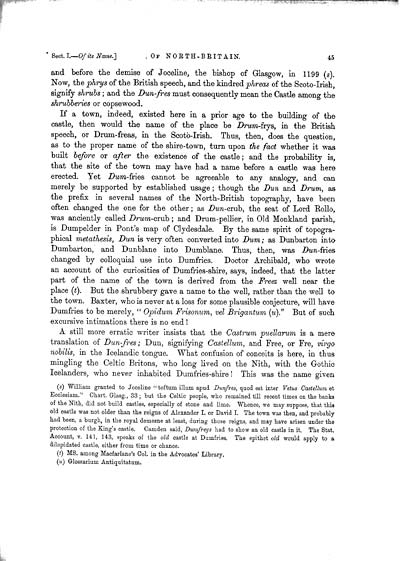Volume 5
(51) Page 45
Download files
Individual page:
Thumbnail gallery: Grid view | List view

45 and before the demise of Joceline, the bishop of Glasgow, in 1199 (s). Now, the phrys of the British speech, and the kindred phreas of the Scoto-Irish, signify shrubs; and the Dun-fres must consequently mean the Castle among the shrubberies or copsewood. If a town, indeed, existed here in a prior age to the building of the castle, then would the name of the place be Drum-frys, in the British speech, or Drum-freas, in the Scoto-Irish. Thus, then, does the question, as to the proper name of the shire-town, turn upon the fact whether it was built before or after the existence of the castle; and the probability is, that the site of the town may have had a name before a castle was here erected. Yet Dum-fries cannot be agreeable to any analogy, and can merely be supported by established usage; though the Dun and Drum, as the prefix in several names of the North-British topography, have been often changed the one for the other; as Dun-crub, the seat of Lord Rollo, was anciently called Drum-crub; and Drum-pellier, in Old Monkland parish, is Dumpelder in Pont's map of Clydesdale. By the same spirit of topogra- phical metathesis, Dun is very often converted into Dum; as Dunbarton into Dumbarton, and Dunblane into Dumblane. Thus, then, was Dun-fries changed by colloquial use into Dumfries. Doctor Archibald, who wrote an account of the curiosities of Dumfries-shire, says, indeed, that the latter part of the name of the town is derived from the Freez well near the place (t). But the shrubbery gave a name to the well, rather than the well to the town. Baxter, who is never at a loss for some plausible conjecture, will have Dumfries to be merely, " Opidum Frisonum, vel Brigantum (u)." But of such excursive intimations there is no end ! A still more erratic writer insists that the Castrum puellarum is a mere translation of Dun-fres; Dun, signifying Castellum, and Free, or Fre, virgo nobilis, in the Icelandic tongue. What confusion of conceits is here, in thus mingling the Celtic Britons, who long lived on the Nith, with the Gothic Icelanders, who never inhabited Dumfries-shire! This was the name given (s) William granted to Joceline " toftum ilium apud Dunfres, quod est inter Vetus Castellum et Ecclesiam.'' Chart. Glasg., 33; but the Celtic people, who remained till recent times on the banks of the Nith, did not build castles, especially of stone and lime. Whence, we may suppose, that this old castle was not older than the reigns of Alexander I. or David I. The town was then, and probably had been, a burgh, in the royal demesne at least, during those reigns, and may have arisen under the protection of the King's castle. Camden said, Dumfreys had to show an old castle in it. The Stat. Account, v. 141, 143, speaks of the old castle at Dumfries, The epithet old would apply to a dilapidated castle, either from time or chance. (f) MS. among Macfarlane's Col. in the Advocates' Library. (u) Glossarium Antiquitatum.
Set display mode to:
![]() Universal Viewer |
Universal Viewer | ![]() Mirador |
Large image | Transcription
Mirador |
Large image | Transcription
Images and transcriptions on this page, including medium image downloads, may be used under the Creative Commons Attribution 4.0 International Licence unless otherwise stated. ![]()
| Caledonia, or, An account, historical and topographic of North Britain from the most ancient to the present times > Volume 5 > (51) Page 45 |
|---|
| Permanent URL | https://digital.nls.uk/74530226 |
|---|---|
| Description | Vol. V. |
|---|---|
| Attribution and copyright: |
|

